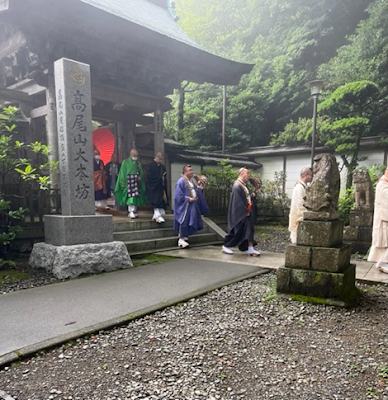It was drizzling in the morning and was a little
cooler after the heavy rain caused by Typhoon No. 13 while the moisture in the
air prevented us from enjoying a clear view from Mt. Takao.
Our guests are six (6) trainees from various countries
(i.e., Cambodia, Cameroon, Ethiopia, Kenya, Lao-PDR and Papua New Guinea) to
Japan International Cooperation Agency (JICA) and Japan International Forestry
Promotion & Cooperation Center (JIFPRO).
Our guests are attended by two (2) people each from JICA and JIFPRO. TENGU team consisted of Nabe-san, Keita-san, Ken-san
and myself as a tour leader. So, our tour members consisted of four-teen (14)
people in total.
Although we were originally scheduled to meet our
guests at 10:00 am in front of the Takaosanguchi Station, the bus arranged by
JICA/JIFPRO was caught in a traffic jam and their arrival was delayed by almost
two (2) hours, which was unfortunate. Eventually, we took a cable car leaving Kiyotaki
Station at noon after we introduced to each other very quickly.
After the six (6) minute cable car ride, we found that
everything was enveloped in a fog or mist. By that time, we had already decided to give up the
idea of going up to the peak of the mountain.
After guiding our guests on Monkey Park, Octopus Cedar
Tree, Flora of Mt. Takao (including its rich biodiversity thanks to the
geographical location, geological features, etc.) and Joshin-mon Gate, it’s
almost lunch time.
Then, we moved on to the peak of Jimben-yama (Jimben
Hill), a little elevated place between Trail No. 1 and Trail No. 4 where there
is a newly established memorial monument for forestry martyrs.
During the lunch time, one of our guests was looking
at me eating an onigiri rice ball with great interest. If fact, he asked me if a piece of black
paper wrapping a rice ball is edible at all. I explained to him that a black paper like one is a
kind of seaweed called “nori”, that Japanese people eat many kinds of seaweed
and that each seaweed has a different name, respectively.
Actually, he had already finished his rice ball lunch
assuming a piece of black paper is a part of wrapping materials. As he was fully aware of our “Don’t leave any
garbage behind” campaign at Mt. Takao, he still kept a piece of black paper as
a part of the garbage he should bring back to the JICA Dormitory. Then, understanding that a piece of black
paper is a part of his lunch, he started eating it with a nice smile! I was happy to see that!
After spending some twenty (20) minutes there, around
1:10 pm we moved back to Trail No. 1 around the Jimben-do which is dedicated to
En-no Gyoja, the founder of Shugendo for some guiding there.
At the fork in Trail No. 1, I tried to convince our
guests to take an easy route nicknamed “women’s slope”, saying that they appeared
to be free from the 108 worldly desires.
Unfortunately, our guests were full of energy (and full
of worldly desires?) and were willing to follow the more challenging route
nicknamed “men’s slope” involving the 108 stone steps to eliminate their 108
worldly desires.
Then, we moved forward on Trail No. 1 guiding on the
list of contributors, huge old cedar trees, Shitenno-mon (the Gate of Four
Heavenly Kings), etc. on the way to the grounds of Yakuo-in Temple.

Guiding and spending some time in the grounds of
Yakuo-in Temple, in front of the living quarters of monks, we were able to
witness the procession of Buddhist monks on the way to their 5th performance of
Buddhist fire ritual called “Goma Fire Ritual” starting at 2:00 pm at the main
hall of Yakuo-in Temple.
After looking at the procession of Buddhist monks and
mountain priests, some of our guests asked us how Buddhist temples are
financially supported, what is the population of Buddhist and Shintoist like,
etc.
In the course of answering their questions, our
explanation to the effect that it is said that Japanese people are born as a
Shintoist and die as a Buddhist and that the aggregate of the population of
Buddhist and Shintoist in Japan is some 1.5 times of the Japanese population might
have been surprising and interesting to them.
Then, going through Nio-mon (the Gate of Heavenly
Kings), we moved on to the main hall of Yakuo-in Temple where our guests were
listening to the monks chanting Buddhist sutra during the Goma Fire Ritual.
The final destination was the Izuna Gongen-do Hall in
this tour. We explained the comparison
between the main hall of Yakuo-in Temple and the Izuna Gongen-do Hall, etc.
We left the
Izuna Gongen-do Hall around 2:30 p.m.
On the way back, we took the same route except that we
detoured by visiting Yuki-en (literally, Joiful Garden) where we saw the Thai
style white stupa and the bronze statue of Izuna Daigongen, the ruler of Mt.
Takao.
Then, for a change, we took a chair lift from the
Sanjo Station to the Kiyotaki Station, which might have been more exciting to our
guests.
We came back to the foot of the mountain around 3:45
p.m. and took a group photo with our guests again in front of the cable car
station, which was the end of the tour.

Written by Shiro
Dated: 11 September 2023













